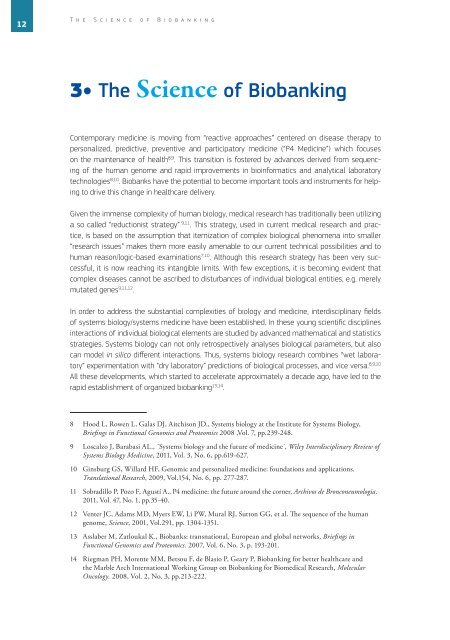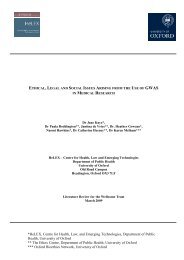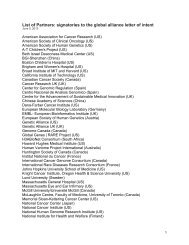Biobanks for Europe - European Commission - Europa
Biobanks for Europe - European Commission - Europa
Biobanks for Europe - European Commission - Europa
- No tags were found...
You also want an ePaper? Increase the reach of your titles
YUMPU automatically turns print PDFs into web optimized ePapers that Google loves.
12T S B3• The Science of BiobankingContemporary medicine is moving from “reactive approaches” centered on disease therapy topersonalized, predictive, preventive and participatory medicine (“P4 Medicine”) which focuseson the maintenance of health 8,9 . This transition is fostered by advances derived from sequencingof the human genome and rapid improvements in bioin<strong>for</strong>matics and analytical laboratorytechnologies 8,10 . <strong>Biobanks</strong> have the potential to become important tools and instruments <strong>for</strong> helpingto drive this change in healthcare delivery.Given the immense complexity of human biology, medical research has traditionally been utilizinga so called “reductionist strategy” 9,11 . This strategy, used in current medical research and practice,is based on the assumption that itemization of complex biological phenomena into smaller“research issues” makes them more easily amenable to our current technical possibilities and tohuman reason/logic-based examinations 7,10 . Although this research strategy has been very successful,it is now reaching its intangible limits. With few exceptions, it is becoming evident thatcomplex diseases cannot be ascribed to disturbances of individual biological entities, e.g. merelymutated genes 9,11,12 .In order to address the substantial complexities of biology and medicine, interdisciplinary eldsof systems biology/systems medicine have been established. In these young scienti c disciplinesinteractions of individual biological elements are studied by advanced mathematical and statisticsstrategies. Systems biology can not only retrospectively analyses biological parameters, but alsocan model in silico dierent interactions. Thus, systems biology research combines “wet laboratory”experimentation with “dry laboratory” predictions of biological processes, and vice versa. 8,9,10All these developments, which started to accelerate approximately a decade ago, have led to therapid establishment of organized biobanking 13,14 .8 Hood L, Rowen L, Galas DJ, Aitchison JD., Systems biology at the Institute <strong>for</strong> Systems Biology,Briefi ngs in Functional Genomics and Proteomics 2008 ,Vol. 7, pp.239-248.9 Loscalzo J, Barabasi AL., ´Systems biology and the future of medicine´, Wiley Interdisciplinary Review ofSystems Biology Medicine, 2011, Vol. 3, No. 6, pp.619-627.10 Ginsburg GS, Willard HF, Genomic and personalized medicine: foundations and applications.Translational Research, 2009, Vol.154, No. 6, pp. 277-287.11 Sobradillo P, Pozo F, Agustí A., P4 medicine: the future around the corner, Archivos de Bronconeumologia.2011, Vol. 47, No. 1, pp.35-40.12 Venter JC, Adams MD, Myers EW, Li PW, Mural RJ, Sutton GG, et al. The sequence of the humangenome, Science, 2001, Vol.291, pp. 1304-1351.13 Asslaber M, Zatloukal K., <strong>Biobanks</strong>: transnational, <strong>Europe</strong>an and global networks, Briefi ngs inFunctional Genomics and Proteomics. 2007, Vol. 6, No. 3, p. 193-201.14 Riegman PH, Morente MM, Betsou F, de Blasio P, Geary P, Biobanking <strong>for</strong> better healthcare andthe Marble Arch International Working Group on Biobanking <strong>for</strong> Biomedical Research, MolecularOncology. 2008, Vol. 2, No. 3, pp.213-222.





